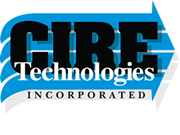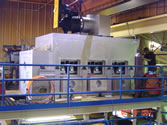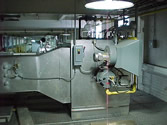Log in
Cire Technologies Blog
Principles of Direct Impingement Dryer Design Series - Paper No. 7 of 8
The Primary Components of an Impingement Dryer – Part 2
In this post we continue and finish the discussion of the primary components of an impingement dryer.
Impingement Nozzles and Supply Plenums
The design and fabrication of the impingement nozzles and supply plenums are very important to the drying effectiveness and uniformity. Characteristics of good design include the following features:
- Uniform spacing of nozzles and nozzle slot widths to facilitate uniform heat transfer to the product.
- Good distribution of the supply air to all nozzles and across the full width of the product. This requires proper design of the nozzles and the nozzle supply plenums. Good design creates a sizeable difference in air velocities of the nozzles and supply plenums. The air velocity should be highest at the nozzle discharge and be significantly slower in the nozzle and the supply plenum.
- The nozzles should be wider than the product.
- The plenum can be designed to be the fully width of the product or a partial width around the centerline of the product (web). Where the web widths are small, you can get away with the plenum being the fully width of the nozzle. However with wider webs the plenums should be partial width to allow the exhaust/recirculation air to be removed from the web without having to leave the web at the sides, over drying the edges in relation to the center of the web.
- The best nozzle design utilizes individual nozzle boxes mounted to a central header with the size of the nozzles designed for uniform supply of the air across the full width of the nozzle and with the header (plenum) designed to uniformly supply the air to all the individual nozzles. This design provides the best removal of the supplied air from the web, keeping the uniformly supplied air uniformly removed from the web.
- Nozzle construction should be air tight, particularly at higher impingement velocities and thus higher supply pressures. The best construction is welded, our standard.
Exhaust and Recirculation Air Collection
As noted in the previous section the means to which the exhaust and recirculated air is removed from the web is important to the uniform heat transfer to the product.
- Good collection removes the supplied air from the web uniformly, between the nozzles. In addition multiple pickup points throughout the dryer along the length of the dryer help maintain the dryer heat transfer uniformity.
- Avoid returning the air at one side of the dryer as this will dry that side of the web more than the opposite side. Picking up the exhaust along the centerline of the web or on both sides of a central header, behind the nozzles, maintains good drying uniformity.
Interconnecting Ductwork
- Proper sizing and design of the interconnecting ductwork is important to minimize pressure drops in the system and prevent fugitive emissions.
- For supply air ductwork we recommend welded construction, insulated to match the maximum temperature capability of the dryer. Insulation can be foil protected or for higher quality systems the insulation is protected by a metal skin. A 20 gauge aluminized or galvanized skin, properly constructed around the insulation will provide years of trouble free service and will withstand abuse where foil systems don't hold up.
- The insulation must be rated for the temperature the duct will experience, failure to do so will result in premature failure of the insulation.
Exhaust Fan
All dryers are required to have exhaust. This is used to help keep the dryer negative to the room it resides in and to remove the solvent, whether water or a VOC. Characteristics of the exhaust fan should include the following:
- The fan can be either a vane axial or centrifugal fan, however we recommend that it should be a centrifugal fan with an airfoil wheel, the most efficient, or a backward inclined wheel, almost as efficient as the air foil wheel.
- The fan motor should be rated for use with variable frequency (speed) drives. We recommend all fans utilize VFDs to provide flexibility to the process, the most efficient control of air flow and reduce wear and tear on the fan components through the use of ramped instead of full speed starts. Though dampers can be used to control exhaust volume we recommend the use of VFDs to achieve this purpose.
- The fan can be belt or direct driven. Belt drives provide some additional flexibility in matching air flow characteristics to the process, however with the use of VFDs direct drive systems can often match the process requirements and are usually cheaper.
Web Support
In horizontal impingement dryers the web must be supported as it travels through the dryer. This is typically done with idler rolls. In some cases the rolls are arranged in an arched configuration and in some cases they are flat. Though some textile and metal coil webs can be greatly tensioned and avoid the need for support in the dryer this is not typical for most impingement dryers.
- In flat dryers the idler rolls must be driven or else the rolls will not turn and the web will drag across the rolls, adversely affecting the uncoated side of the web.
- Driven rolls can be directly driven through a gear box and motor arrangement with VFDs controlling the rotational speed to match the web, or more commonly the rolls are driven by a single motor with the rolls connected to each other through timing belts or chains.
- Arched dryers either use the wrap of the web on the roll to turn the roll or include tendency drives to assist the web because the wrap of the web is not great enough to turn the roll without assistance.
- Idler rolls are usually fabricated out of steel, stainless steel or aluminum and can be finished in a multitude of ways to improve corrosion resistance, cleaning and frictional characteristics.
- The idler rolls can be dead shaft or live shaft rolls. Dead shaft rolls include bearings between the roller and its shaft so that the face of the roll rotates around the stationary shaft. These idler rolls just need simple support of the shaft. Care must be taken if using dead shaft idler rolls to make sure the grease in the bearings is compatible with the dryer temperature and solvent.
- Live shaft idler rolls are fixed to the roll shaft so when the idler turns the shaft turns. In most cases these are preferable. We recommend supporting the shafts with low friction bearings mounted outside of the dryer to operate outside of the temperature and solvent atmosphere. The supports should be substantial structural steel to avoid movement of the mounts an adverse web tracking. One side of the dryer box should be configured to allow the idler roll to be installed and removed from the dryer easily through one side.
When you subscribe to the blog, we will send you an e-mail when there are new updates on the site so you wouldn't miss them.





Comments